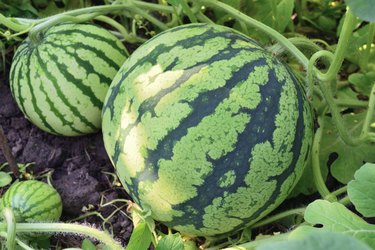
Both watermelons (Citrullus lanatus) and cantaloupes (Cucumis melo) are members of the cucumber family, Cucurbitaceae. These annual vines with long, sprawling stems take up a large area in a garden and need lots of sunshine and warm temperatures to produce well. So can you plant these similar vining plants together? No, you shouldn't plant watermelon and cantaloupe vines close to one another because of the space requirements and shared pest and disease concerns, but you can plant them in a larger bed in different areas with good cultural practices.
Both Require Lots of Space
Video of the Day
The foremost concern in planting both cantaloupe and watermelons in the same garden bed is space. The vines of both melons spread far and will grow wherever they can to access sunlight. Plants too close together cause unnecessary competition for light, soil moisture, and nutrients. Dense vegetation may also lead to humid conditions on the soil surface and increase the chances of fungal diseases. If space is an issue, modern varieties include some bush types which mature with short vines and may be more suitable for the dimensions of your garden.
Video of the Day
Pollination Concerns With Close Plants
Closely related vegetable vines like pumpkins (Cucurbita pepo) and squash (Cucurbita) cross-pollinate each other's flowers and can yield awkward, inconsistent hybrid fruits. Watermelons and cantaloupes don't cross-pollinate or create hybrid fruits. However, you should expect different varieties of cantaloupes, honeydews, and muskmelons to cross-pollinate each other within close range in the garden. Depending on genetics, this may lead to fruits with variable fruit qualities that aren't always desirable. Keeping different types of melons separate eliminates this issue.
Disease and Pest Concerns
Since watermelons and muskmelons are susceptible to many of the same pests and diseases, growing both crops in a garden bed may be problematic. For example, if the watermelon is attacked by stem borers and not treated, the pest can quickly spread and harm nearby cantaloupe vines.
Potential disease problems exist, including threats from alternaria blight, bacterial wilt, fusarium wilt, leaf spot, and powdery and downy mildews. Cucumber beetles, squash vine borers, pickleworms, and squash bugs also attack both plants. Cucumber beetles tend to spread the bacterial wilt disease around the garden. If you place watermelons and cantaloupes in different garden beds, you reduce the risk of diseases and pests spreading until you can get them under control.
Watermelon and Cantaloupe Growing Tips
Watermelons and cantaloupes can grow and produce well in the same spacious garden bed if you give them plenty of space. Ideally, you want to place them in separate garden beds or on opposite ends of a large garden. If the gardener remains conscientious about monitoring for weeds, disease, and insect pests, any potential major cultural problems can be avoided or treated.
Encourage a chemical-free, bee-friendly garden so honeybees and bumblebees pollinate the melon flowers. Also, consider placing developing melon fruits on a piece of scrap plywood to keep them from resting directly on the moist garden soil. This prevents rot and can assist in limiting access of insects to the ripening fruits.